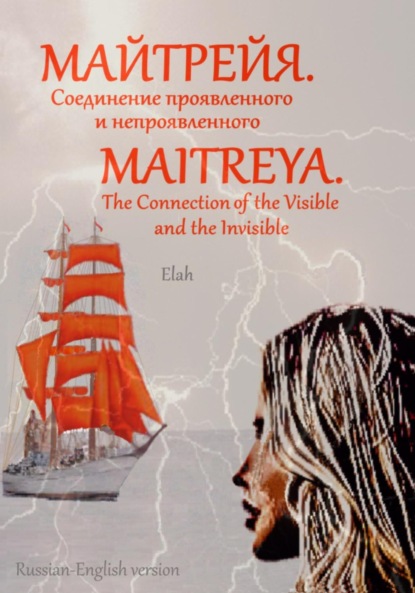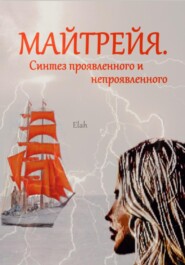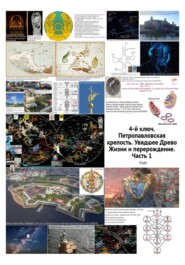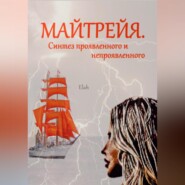По всем вопросам обращайтесь на: info@litportal.ru
(©) 2003-2024.
✖
Майтрейя. Слияние проявленного и непроявленного Maitreya. The Connection of the Visible and the Invisible
Настройки чтения
Размер шрифта
Высота строк
Поля
The first hall was small, like an apartment of the aristocratic intelligentsia of the late XIX – early XX century: tables covered with tablecloths, chairs with covers, the buffet showcase in walnut wood with the kitchenware, two twisted wrought iron stand with potted plants. A wooden console with a mirror in a carved frame of silver plated, candlesticks with candelabras stood on the console.
На стенах в рамках висели рисунки, на которых были изображены сюжеты из произведений Булгакова. Из обстановки прошлого стояло еще черное пианино со стулом. Между рисунками, как мостик в современность, на стенах разместились телевизионные экраны. Люстры на потолке и бра на стенах в классическом стиле с тканевыми абажурами светили мягким светом.
Drawings in the frames hung on the walls; plots from the works of Bulgakov were depicted on them. A black piano with a chair from the past was also in the hall. Television screens, located on the walls between pictures, were as a bridge to the present. Chandeliers on the ceiling and sconces on the walls in a classic style with fabric shades shone in the soft light.
Зал был очень уютный, мне он напомнил квартиру семьи Турбиных из романа «Белая гвардия» Булгакова. И некоторые из сюжетов на рисунках были из этого романа. Школьницей я сначала посмотрела фильм-сериал «Белая гвардия»[19 - Булгаков Михаил Афанасьевич, «Белая гвардия» (1922—1924), первый роман Михаила Булгакова. Описываются события Гражданской войны на Украине в конце 1918 года. Роман повествует о семье русских интеллигентов и их друзьях, которые переживают социальный катаклизм гражданской войны. ИсточникВикипедия.], а потом уже прочла книгу. Роман тогда увлек меня, как и жизнь, показанная в нем…
The hall was very cozy; it reminded me of the apartment of a family Turbiny from the novel "The White Guard" Bulgakov[20 - Mikhail Bulgakov "The White Guard" (1922-1924), the first novel by Mikhail Bulgakov describes the events of the Civil war in Ukraine in late 1918. The novel tells the story of the family of Russian intellectuals and their friends who are experiencing social cataclysm of the Civil war. Source Wikipedia.]. And some of the scenes in the pictures were from this novel. A schoolgirl, I first watched the series "The White Guard" and then read the book. The novel drew me then, as the life, shown in it. . ..
Второй зал был не менее чем в два раза больше первого и имел прямоугольную форму. Отдельные элементы его оформления относились к Римской эпохе, другие перекликались с не так отдаленным временем. Перед глазами возник еще один роман писателя – «Мастер и Маргарита»[21 - Булгаков Михаил Афанасьевич, «Мастер и Маргарита» (роман, 1929—1940, в СССР опубликован в 1966—1967 годах, второй вариант в 1973 году, окончательный вариант в 1990 году). Над этим романом Булгаков начал работать в конце 1920-х годов и продолжал вплоть до своей смерти. Действие романа начинается в один из майских дней, когда два московских литератора – председатель правления МАССОЛИТа Михаил Александрович Берлиоз и поэт Иван Бездомный – во время прогулки на Патриарших прудах встречают незнакомца, похожего на иностранца. Он включается в разговор об Иисусе Христе, рассказывает о своём пребывании на балконе прокуратора Иудеи Понтия Пилата и предрекает, что Берлиозу отрежет голову «русская женщина, комсомолка». Литераторы не знают, что перед ними Воланд – дьявол, прибывший в советскую столицу со своей свитой – Фаготом-Коровьевым, Азазелло, котом Бегемотом и служанкой Геллой. ИсточникВикипедия.]. Именно в нем удивительно переплелись эпоха Древнего Рима и время начала Советского Союза. Роман о дьяволе, написанный мастером пера.
The second hall was not less than two the first and had rectangular. Some elements of its design belonged to the Roman era, others – to the not-so-distant time. Another novel of the writer appeared before my eyes – "The Master and Margarita."[22 - Mikhail Bulgakov, "The Master and Margarita" (novel, 1929-1940, published in the USSR in the years 1966-1967, the second option in 1973, the final version in 1990). Bulgakov began working on this novel in the late 1920s and continued until his death.The novel alternates between two settings. The first is 1930s Moscow, where Satan appears at the Patriarch Ponds in the guise of "Professor" Woland, a mysterious gentleman "magician" of uncertain origin. He arrives with a retinue that includes the grotesquely dressed valet Koroviev; the mischievous, gun-happy, fast-talking black cat Behemoth; the fanged hitman Azazello; the pale-faced Abadonna; and the witch Hella. They wreak havoc targeting the literary elite and its trade union MASSOLIT. Its privileged HQ is Griboyedov's House and is made up of corrupt social climbers and their women (wives and mistresses alike), bureaucrats, profiteers, and, more generally, skeptical unbelievers in the human spirit.The second setting is the Jerusalem of Pontius Pilate, described by Woland in his conversations with Berlioz and later echoed in the pages of the Master's novel. This part of the novel concerns Pontius Pilate's trial of Yeshua Ha-Notsri, his recognition of an affinity with, and spiritual need for, Yeshua and his reluctant but resigned submission to Yeshua's execution. Source Wikipedia.] The time of Ancient Rome and the start time of the Soviet Union intertwined in surprising ways in it. The novel about the devil that a master of the pen wrote.
Полуколонны-пилястры по стенам в зале, многоуровневый потолок со скрытыми светильниками, создающими эффект «льющегося» сверху естественного света солнца, полы под натуральный мрамор и фреска на стене в конце зала – все это переносило вошедшего во времена древнего Рима.
Pilasters on the walls in the hall, tiered ceiling with hidden lighting, creating the effect of the natural light "pouring" from the top, floors made of material similar to natural marble and a fresco on the wall at the end of the room – all it moved the visitor to days of Ancient Rome.
На фреске я сразу узнала одного из героев романа – римского прокуратора Иудеи Понтия Пилата[23 - ПонтийПилат (лат. Pontius Pilatus) – римскийпрефектИудеи c 26 по 36 годын.э.Согласно Новому Завету, Понтий Пилат во время суда трижды отказывался предать Иисуса Христа смерти, в которой был заинтересован синедрион во главе с первосвященником Каиафой. ИсточникВикипедия.] с его любимой собакой Бангой:
On the wall in the mural, I immediately recognized the Roman Procurator of Judea, Pontius Pilate[24 - Pontius Pilate (lat. Pontius Pilatus), was the fifth prefect of the Roman province of Judaea from AD 26–36.According to the canonical Christian gospels, Pilate presided at the trial of Jesus and, despite stating that he personally found him not guilty of a crime meriting death, sentenced him to be from crucified. Pilate is thus a pivotal character in the New Testament accounts of Jesus. Source Wikipedia.], one of the heroes of the novel, with his favorite dog Banga:
Крытая колоннада дворца, Понтий Пилат возлежит на своем ложе во дворце, ниже на мозаичном полу легла его собака, которую он гладит по голове. На Прокураторе белый талиф – одежда римлян, представляющая из себя прямоугольное полотно из ткани с отверстием посередине для головы, и в дополнение к нему пояс. Сверху на талиф накинут белый же плащ с красным подбоем, на плече Прокуратора плащ застегнут на пряжку. Перед Понтием Пилатом фонтан, дальше за фонтаном колоннада. За ней сад с кипарисами и пальмами, и совсем вдалеке видны очертания города Ершалаим. Понтий Пилат смотрит в небо. Там, куда устремлен его взгляд, по небу идут два человека и о чем-то беседуют. Они идут высоко в небе. Кто это? Увидеть трудно, но возле одного из них бежит собака…
A covered colonnade of the Palace, Pontius Pilate reclines on his bed in the Palace; his dog, whom he pats on the head, lay down on the mosaic floor. The Procurator dressed in a white talif – the clothing of the Romans, it is a rectangular canvas made of cloth with a hole for their head and a belt to complement it. Also the white cloak, but with red trim, clad on top of the talif. The cloak fastened on the shoulder of the Procurator on the buckle. The fountain is in front of Pontius Pilate; behind the fountain, colonnade is. Beyond it, there is a garden with cypresses and palm trees, and the outlines of the city Jerusalem is visible quite in the distance. Pontius Pilate looks at the sky. There in it, where he watches, two men walk and talk about something. They go high in the sky. Who is it? It's difficult to see, but the dog runs near one of them. . ..
После фрески я «пошла» разглядывать остальные изображения с героями романа «Мастер и Маргарита» из другого времени, описанного в романе. Они были развешены по стенам. Художник изобразил сцены с героями из романа в виде черно-белых плакатов с яркими цветными деталями.
After looking the fresco, I "went" to see other drawings with the characters of the novel "The Master and Margarita." They were from another time, described in the novel, and hung on the walls of the hall. The artist has depicted the scene with the characters from the novel in the form of black-and-white posters with bright color details.
Вот огромный черный кот Бегемот из романа висит наверху шторы на окне и, обхватив лапой закопченный зеленый примус, пьет из него бензин, а внизу цветные языки пламени уже поднимаются по шторе. Дальше Маргарита в образе ведьмы пролетает на щетке над Москвой, сияющей ночными огнями.
Here a huge black cat Behemoth from the novel hangs above the curtains on the window, and holding in his paw smoked green Primus, drinking from it gasoline, and the bottom colored flames already climb up on the curtain. Then, Margarita in the image of witches is flying on the brush over Moscow, shining night lights.
Еще один плакат, на котором Воланд, он же Сатана, сидит с литераторами на скамейке у Патриарших прудов. А вот и Азазелло, помощник Воланда, Мастер и Маргарита. Они сидят в подвальчике за накрытым столом и пьют фалернское вино. Оно играет цветом в бокалах, то самое вино, которое пил прокуратор Иудеи…
Another poster, where Woland aka Satan, sits together with writers on a bench at Patriarch's ponds. And here are Azazello the assistant Woland, Master, and Margarita. They sit in the cellar for the dinner's table and drink a Falernian wine. It plays the color in the glass, the same wine that the Procurator of Judea was drinking. . ..
Плакаты создавали резкий контраст по отношению к фреске, полуколоннам, потолку, но это сочетание только наполняло пространство энергией, делало его динамичным, интересным. Было в этом оформлении что-то притягательное. Сюда хотелось попасть, хотя бы раз увидеть все и почувствовать эту энергию на месте.
Posters created a stark contrast compared to the fresco, pilasters, the ceiling, but this combination only filled the space of the room with the energy and made it dynamic and interesting. Something attractive was in this design. Here I wanted to be at least once to see everything and to feel the energy of this place.
Вдоль стены с окнами перпендикулярно к ней стояли прямоугольные столы с мягкими диванами. В остальной части помещения столы были круглые, небольшие, вокруг них – мягкие же стулья-кресла. Не было ни скатертей на столах, ни чехлов на стульях. В начале зала вдоль стены напротив окон располагалась большая черная барная стойка с рядом барных стульев, на самой стойке стояли плазменные телевизоры. По всему помещению и в углах зала были расставлены зеленые декоративные деревца, искусственные или живые.
Rectangular tables with soft sofas stood along the wall with windows is perpendicular to it. In the rest of the hall, tables were round, small, and around them – upholstered arm-chairs. There were no tablecloths on the tables, no covers on chairs. A big black bar with bar stools located at the beginning of the hall along the wall opposite windows. Plasma TVs was right on the bar counter. Green decorative trees, artificial or live, were placed in different parts of the room.
Вход был сбоку, а посередине стены стояли два кресла. Сидя в них, можно было беседовать и разглядывать фреску на противоположной стене в другом конце зала, или наблюдать за посетителями в зале. Или смотреть на… костер. Он располагался между креслами прямо на мраморном полу. «Живая» голографическая[25 - Голография (др.-греч. – [holos ] – «полный, целый» + [graphe] – «письмо, рисунок») – набор технологий для точной записи, воспроизведения и переформирования волновых полей оптического электромагнитного излучения, особый фотографический метод, при котором с помощью лазера регистрируются, а затем восстанавливаются изображения трехмерных объектов, в высшей степени похожие на реальные. Данный метод был предложен в 1947 году Дэннисом Габором, он же ввёл термин голограмма и получил «за изобретение и развитие голографического принципа» Нобелевскую премию по физике в 1971 году. ИсточникВикипедия.] инсталляция. В костре горела рукопись. «Рукописи не горят», – кажется, так сказал Воланд в романе «Мастер и Маргарита». Вероятно, инсталляция отображала эти строки из романа. Огонь в костре выглядел очень реально. Пойду в ресторан, чтобы увидеть его, это точно. Мистика. Да уж, в «Булгакове» без нее было не обойтись…
The entrance was a side, and two chairs stood in the middle of the wall. It was possible to sit in the chair and talk about anything, watching on the fresco that was on the opposite wall at the end of the hall, or observe visitors in the room, or look at… the fire. It was between chairs directly on the marble floor. A "live" holographic[26 - The word holography comes from the Greek words (holos; "whole") and (graphe "writing" or "drawing"). How it works. Holography is a technique that enables a light field, which is generally the product of a light source scattered off objects, to be recorded and later reconstructed when the original light field is no longer present, due to the absence of the original objects. Holography can be thought of as somewhat similar to sound recording, whereby a sound field created by vibrating matter like musical instruments or vocal cords, is encoded in such a way that it can be reproduced later, without the presence of the original vibrating matter. The Hungarian-British physicist Dennis Gabor (in Hungarian: Gabor Denes), was awarded the Nobel Prize in Physics in 1971 "for his invention and development of the holographic method". Source Wikipedia.] installation. And the manuscript was burning in the fire. "Manuscripts do not burn", it seems, Voland said so in the novel "Master and Margarita". Likely, the installation displayed it from the novel. The fire looked very real. I'll go to the restaurant to see it is sure. Mystic – yeah, it was impossible to do without it in the "Bulgakov". . ..
Я поднялась с дивана и прошла в комнату родителей. Здесь была большая библиотека во всю стену. Родители предпочитали электронным версиям книг бумажные, которые можно было держать в руках и не спеша читать, делать закладки, что-то отмечать на полях, писать комментарии. Каждая книга так становилась особенной, хранящей в себе не только то, что написал автор, но и мысли своего владельца.
I got up the sofa and went to the room of parents. Here was a book library on all wall. Parents preferred the paper books electronic versions that you can hold in your hands and slowly read, make bookmarks, mark something on the pages, write comments. Thus, each book was becoming unique, keeping not only that the author wrote, but the thoughts of its owner also.
У родителей в комнате как дополнение к библиотеке стояли старые кресло и торшер. В кресле под этим торшером любила сидеть моя мама и читать книги. Она и привила мне любовь к чтению и к бумажным книгам. Для меня в них какая-то своя, особая энергетика…
Old armchair and a floor lamp stood in the room of parents as an addition to the library. My mother loved to sit and read books in the chair under this lamp. She instilled in me a love of reading and a love of paper books. For me, they own especial energetic. . ..
Книга «Мастер и Маргарита» Михаила Булгакова была в нашей библиотеке. Я «пробежала глазами» по корешкам книг, нашла ее, взяла и вернулась в гостиную. Ноутбук остался в стороне, а я сидела с книгой, перечитывая роман.
The book "Master and Margarita" by Mikhail Bulgakov was in our library. I "glanced through" on the spines of books, found it, gave up and went back into the living room. The laptop is left behind, and I was sitting with a book, re-reading the novel.
Я прочла его заново, не отрываясь, до конца. Жалко было расставаться с полюбившимися героями, со всей так увлекательно описанной чертовщиной, которая по замыслу писателя произошла в Москве после приезда Воланда-Сатаны и его свиты. Сам роман был как глоток свободы, пьянящей и окрыляющей. Только прочитав его весь, «выпив все капли» этой свободы, «вылитой» автором на страницы книги, довольная, лишь утром я легла спать.
I read it again, not stopping until the end. It was a pity to part with favorite characters, with all so exciting described the devilry that, according to the intention of the writer, took place in Moscow after the arrival of Woland-Satan and his retinue. The novel was like a breath of freedom, intoxicating and inspiring. Only after reading the book, "after drinking all the drops" of this freedom, transferred by the author on the pages of the book, I went to bed satisfied, only in the morning.
Глава 17. Сон: «Книга жизней» / Chapter 17. Sleep: Book of Lives
Мы с Алексой сидели на креслах в зале ресторана. Алекса играла язычками огня в костре, проводя по ним рукой. Странно, как огонь не обжигал ее, я видела в костре горящие ветки и слышала, как они потрескивают. В костре лежала рукописная книга, ее страницы обгорали, сворачивались и разворачивались вновь, они восстанавливались и опять горели. Каждый раз, когда страницы разворачивались, текст на них менялся, словно они заново переписывались.
Alexa and I were sitting on the chairs in the restaurant. Alexa played with the flames, passing her hand on it. It was strange that the fire was not burning her, although I saw the branches burning in the fire, and heard them crackling. A manuscript book was in the fire; its pages were burning, crumpling and unfolding again; they were recovering, and again burning. Every time pages unfolded, the text on them has varied as if written again.
– Странный огонь, как он тебя не обжигает? И почему текст на страницах меняется? – спросила я.
"Strange fire, how it does not scorch you? And why is the text on the pages varies?" I asked.
– Это огонь жизни, разве он может меня обжечь, – улыбнулась Алекса. – А текст на страницах – истории разных жизней. Одно воплощение сменяется другим, и новая история уже другая. У каждого человека есть книга его жизней, она как бесконечный роман с разными-разными историями…
"This is the fire of life; it can't burn me," smiled Alexa. "And the text on the pages is stories of different lives. One embodiment replaced by another, and a new story is another. Each person has a book of his lives; it is like a never ending novel with a variety of different stories. . .."
– Разве мы не одну жизнь живем?
"Have we not one life to live?"
– Нет, за одну жизнь многому не научишься.
"No, you don't learn much in one life."
– Что ты имеешь в виду?
"What do you mean?"
– Чтобы стать гением, к примеру, нужна не одна, а несколько жизней, в которых человек будет совершенствоваться в своем мастерстве. Лишь освоив его, он сможет воплотиться и прожить очередную жизнь в этом мире как гений.
"To become a genius, for example, a person needs not one, but several lives in which he will be improving his skill. Only a way he can reincarnate and live another life in this world as the genius."
Идея о том, что каждый человек приходит в этот мир не один раз, не была для меня новостью, но как-то раньше я над ней не задумывалась. Да и сейчас пока она меня мало интересовала.
The idea that every person comes into this world not once was not news to me, but I never really thought about it. And now I didn't have much interest in this.








